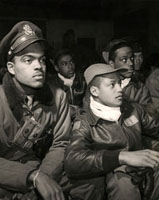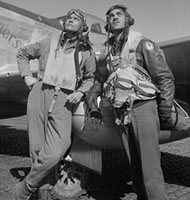Segregation permeated Army behavior in the early days of World War II. Many segregated black units were assigned to posts and bases in the southern United States for training, where commanders applied "local laws and customs," which often meant strict segregation. The practice of segregation even spread to northern facilities and overseas, so that posts and bases in these areas were segregated even when the local communities were not. A military report in 1943 noted that
the Army, by its directives and by actions of commanding officers, has introduced Jim-Crow practices in areas, both home and abroad, where they have not heretofore been practiced.[1]

-James C. Warren[2]
Black Americans engaged in a variety of tactics to demonstrate their dissatisfaction with official military segregation. While some resorted to violence and others wrote letters, a number of black Americans acted with discipline, organization, and a commitment to non-violent methods against unequal treatment by the military; against segregated military transportation; and against segregated facilities like post and base exchanges, movie theaters, and officers’ clubs. This was a true grassroots movement, involving small groups, using a number of methods at a number of different locations, and without centralized leadership.

The War Department might have known that race relations in the military were going to be a problem when the United States entered World War II. About 200,000 black Americans had served in France during World War I, some in combat units, and black Americans had protested their treatment by the military before and during that war. Perhaps the only surprise is how long it took the military to come to terms with the problems that occurred during WWII. As the size of America’s military grew throughout the War, the number of black Americans in uniform would increase, and so would the protests against the military’s formal and informal segregation policies.

Black Americans, particularly the men trained as pilots, were willing and able to challenge the military's policies in World War II. As Bernard Nalty notes, "The kind of man selected to become a pilot and leader of men was highly unlikely to submit to a clearly illegal policy [like on-post segregation]."[3] The War Department agreed. As early as 1941, a civilian aide to the Secretary of War warned his superiors that "[i]n the Army the Negro is taught to be a man . . . . It is impossible to create a dual personality which will be on the one hand a fighting man toward the foreign enemy, and on the other, a craven who will accept treatment as less than a man at home."[4] A 1943 War Department memorandum noted that "military training does not develop a spirit of cheerful acceptance of Jim Crow laws and customs."[5] The War Department would increasingly find that to be true as black Americans rebelled against segregationist War Department policies and practices.
[1] "Memorandum, Brigadier General Davis, for Assistant Secretary of War, Chairman, Advisory Committee for Special Troop Policies (Negro Troops), November 10, 1943," reprinted in Morris J. MacGregor and Bernard C. Nalty, eds., Blacks in the United States Armed Forces: Basic Documents VII (Wilmington: Scholarly Resources, Inc, 1977), 292.
[2] James C. Warren, The Freeman Field Mutiny, reprinted ed. (Vacaville, CA: The Conyers Publishing Company, 1997), 5.
[3] Bernard C. Nalty, Strength for the Fight: A History of Black Americans in the Military (New York: The Free Press, 1986), 157.
[4] "Memorandum, Civilian Aide to the Secretary of War, for Secretary of War, September 22, 1941, Subject: Survey and Recommendations Concerning the Integration of the Negro Soldier into the Army," reprinted in MacGregor and Nalty, Blacks in the United States Armed Forces: Basic Documents V, 80.
[5] "Memorandum, Office of the Inspector General, for Honorable John J. McCloy, the Assistant Secretary of War, Chairman, Advisory Committee for Special Troop Policies, November 10, 1943," reprinted in MacGregor and Nalty, Blacks in the United States Armed Forces: Basic Documents V, 292
